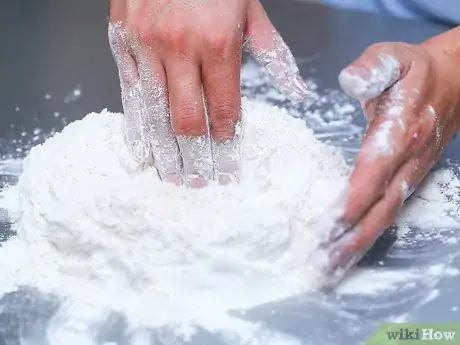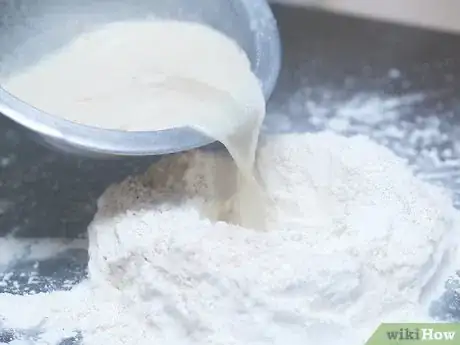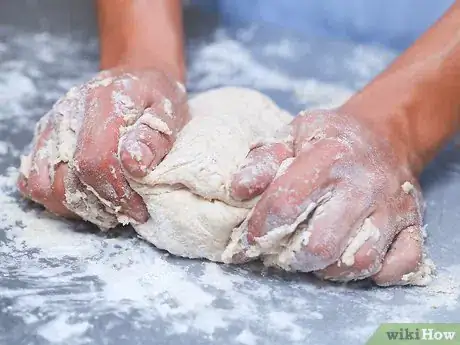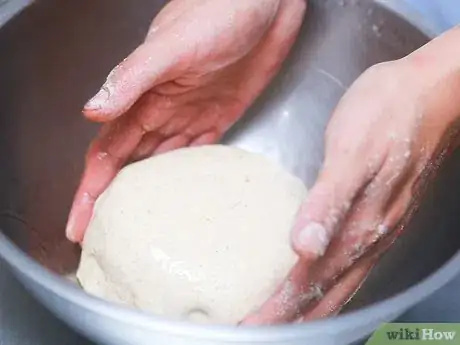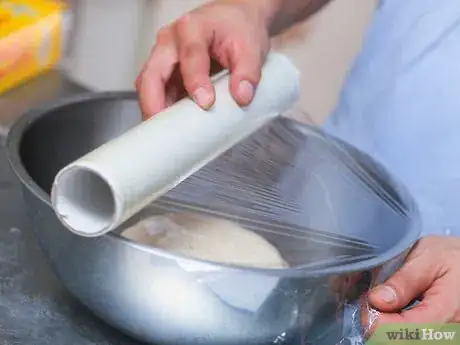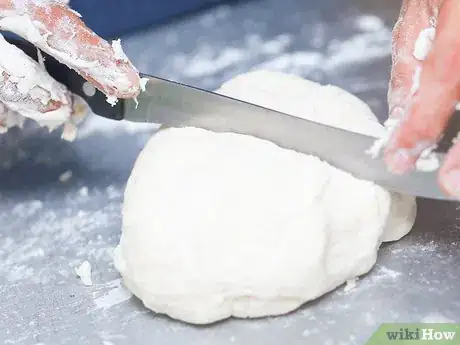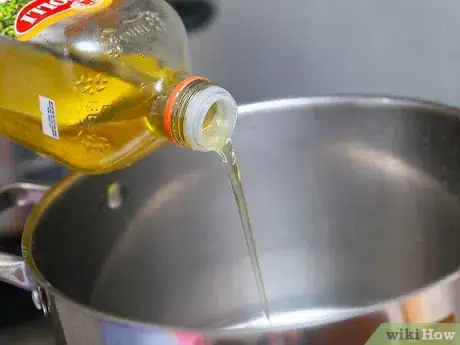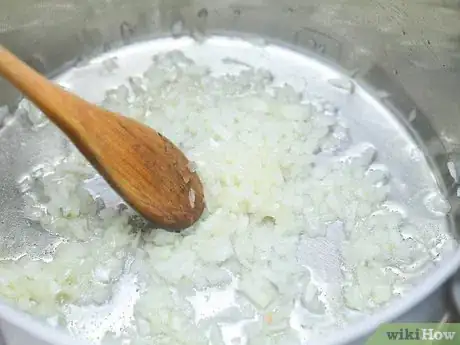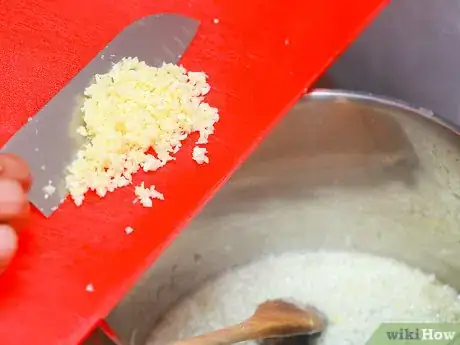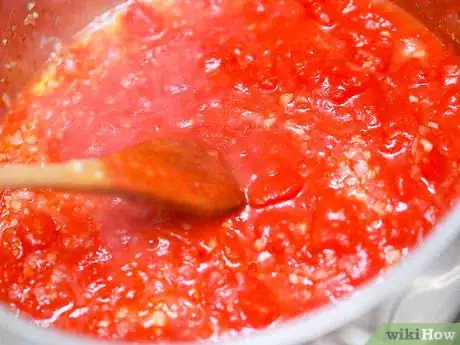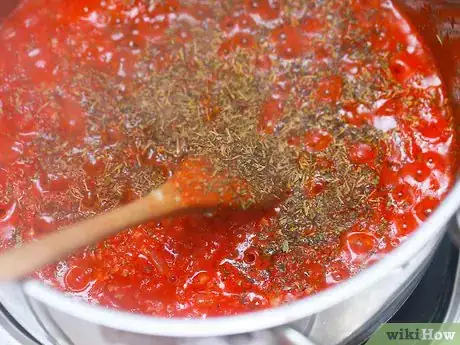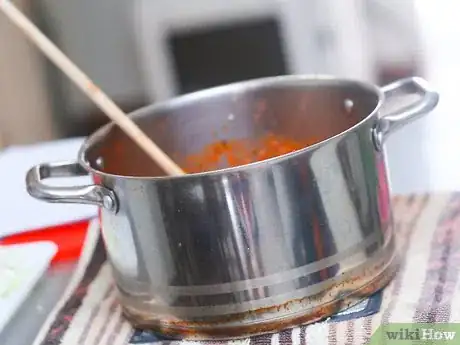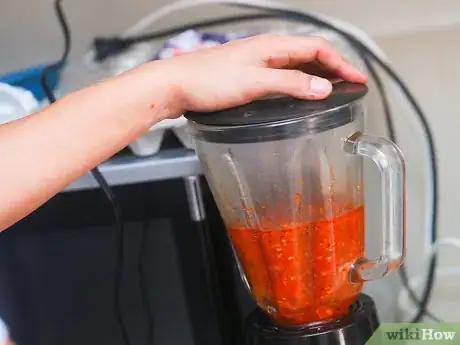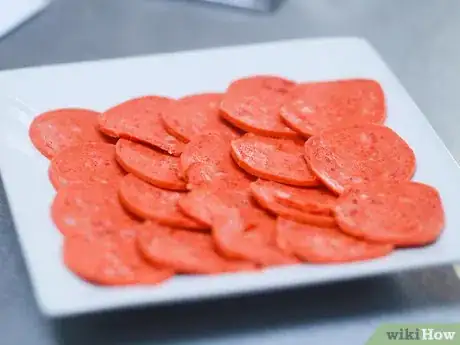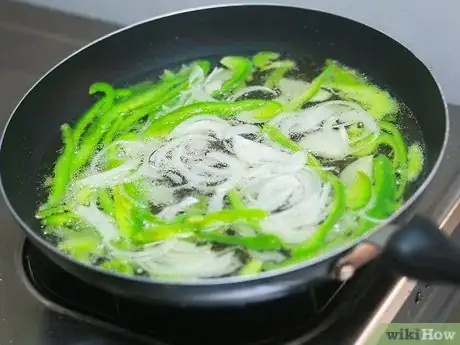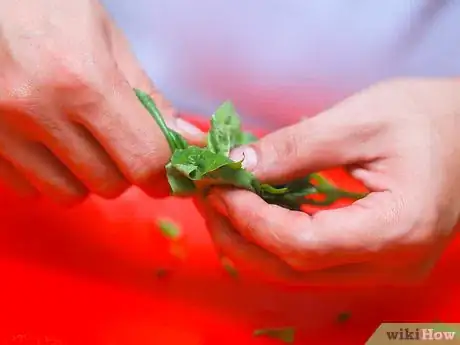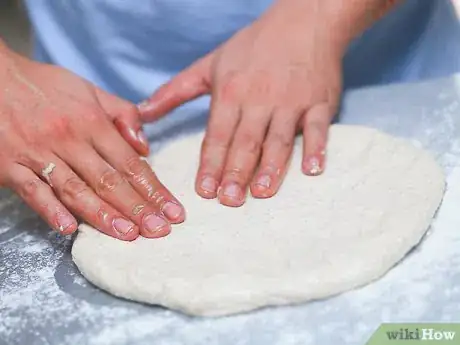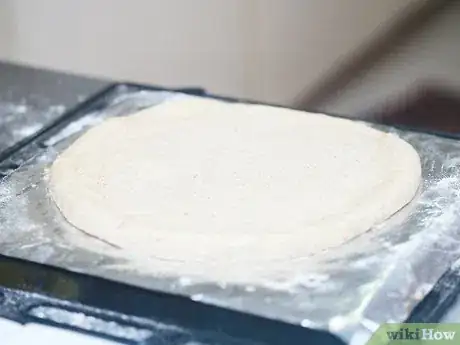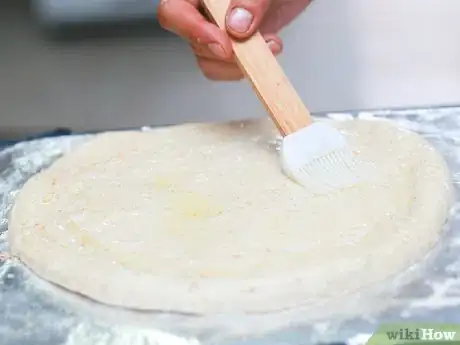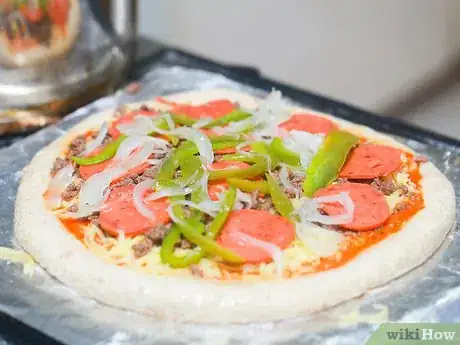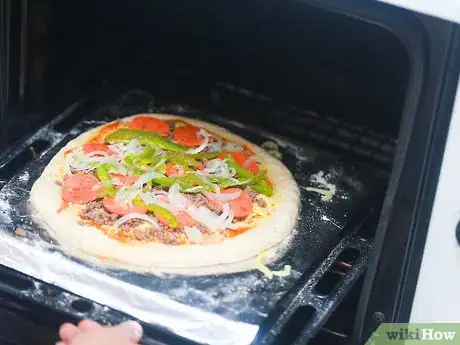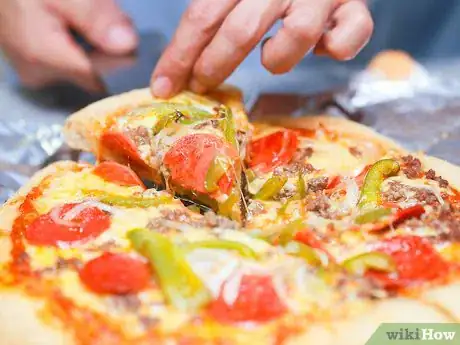This article was co-authored by Ollie George Cigliano. Ollie George Cigliano is a Private Chef, Food Educator, and Owner of Ollie George Cooks, based in Long Beach, California. With over 20 years of experience, she specializes in utilizing fresh, fun ingredients and mixing traditional and innovative cooking techniques. Ollie George holds a BA in Comparative Literature from The University of California, Berkeley, and a Nutrition and Healthy Living Certificate from eCornell University.
wikiHow marks an article as reader-approved once it receives enough positive feedback. In this case, 100% of readers who voted found the article helpful, earning it our reader-approved status.
This article has been viewed 147,852 times.
Pizza is yummy, filling, and relatively easy to make. Plus, you can create this delish treat right from your own home! Prepare the dough, sauce, and ingredients separately. Once each of these elements is ready, combine them and cook the pizza at a high temperature until it turns crispy and delicious.
Ingredients
Makes enough for two 10-inch to 12-inch (25.4-cm to 30.5-cm) pizzas
- 1-1/2 cups (375 ml) warm water
- 1 package or 2-1/4 tsp (11.25 ml) active dry yeast
- 3-1/2 cups (875 ml) bread flour
- 2 Tbsp (30 ml) olive oil
- 2 tsp (10 ml) salt
- 1 tsp (5 ml) sugar
Makes 2 cups (500 ml) of sauce
- 1 Tbsp (15 ml) olive oil
- 2 tsp (10 ml) minced garlic
- 1/4 cup (60 ml) minced sweet onion
- 1/2 tsp (2.5 ml) dried oregano
- 1/2 tsp (2.5 ml) dried basil
- 1 lb (450 g) diced fresh tomatoes OR 14.5-oz (430-ml) can of diced tomatoes, undrained
- 1/2 tsp (2.5 ml) sugar
- 1/4 tsp (1.25 ml) salt
- 1/4 tsp (1.25 ml) ground black pepper
Makes enough for 1 or 2 pizzas
- 8 oz (225 g) mozzarella cheese
- 4-inch (10-cm) stick of pepperoni
- 4 oz (110 g) bulk sausage
- 1/2 of a small onion, roughly chopped
- 1 sweet bell pepper, roughly chopped
- Olive oil
- 1/4 cup (60 ml) fresh basil
- 1 to 2 Tbsp (15 to 30 ml) olive oil
- 1/4 cup (60 ml) cornmeal
Steps
Preparing the Pizza Dough
-
1Combine the water, yeast, salt, and sugar. Place all four ingredients in a small mixing bowl and stir gently to combine.
- Ideally, the water should be "blood temperature," or between 96 to 98.6 degrees Fahrenheit (35.5 to 37 degrees Celsius).
- Allow the mixture to sit for 5 minutes, or until the yeast fully dissolves and starts to foam.
-
2Form a well with the flour. Dump the flour out onto a clean, sturdy work surface and form it into a mound. Use your hands to alter the shape of this mound into a deep well with high walls.[1]
- For this recipe, you'll knead the dough by hand. If you plan to use a stand mixer, however, you can place the flour into the bowl of the mixer instead of the table or counter.
Advertisement -
3Gradually combine the water and flour. Add one-third of the water mixture. Use a fork to carefully knock some of the flour from the wall of the well into this puddle, but do not allow the well to collapse.
- After mixing the water into the flour, repeat this step with another one-third of the water, followed by the remaining third.
- When finished, a very sticky dough should form.
-
4Knead for 10 minutes. Dust your hands with flour, then knead the dough by hand for 10 minutes. Stop only when the dough feels firm and cohesive.
- If you'd prefer to knead the dough using a stand mixer, fit it with the dough hook attachment and work the dough on low to medium spread for 10 minutes.[2]
-
5Place the dough in an oiled bowl. Spread the olive oil over the bottom and sides of a large mixing bowl. Place the dough inside, then turn it several times to coat the surface of the dough with oil.
-
6Let the dough rise. Cover the bowl with plastic wrap and allow it to sit in a warm spot for 60 minutes, or until the dough doubles in size.
- Ideally, the air temperature should be between 75 and 85 degrees Fahrenheit (24 to 29 degrees Celsius).
- If you do not have a warm enough spot, heat the oven to 150 degrees Fahrenheit (65 degrees Celsius). Turn off the preheated oven and give it several minutes to cool slightly, then allow the bowl of dough to rise inside.
-
7Divide the dough. Separate the risen dough into two halves. Roll each half into a ball.
- Place the balls of dough 1 inch (2.5 cm) apart on a lightly floured surface. When they expand enough to touch, they'll be ready to use or store.
- If you wish to save one or both rounds for another time, you can place the dough in an airtight container and freeze it for up to two weeks. Fully thaw frozen dough to room temperature before working with it, though.
Preparing the Pizza Sauce
-
1Crush the tomatoes. Place the diced tomatoes into a medium mixing bowl and crush them using the back of a fork. Continue until the tomatoes are soupy, yet still chunky.[3]
- If you don't mind getting your hands dirty, you could also crush the tomatoes by hand instead of using a fork. Doing so would actually make it easier to control the process.
- Set the tomatoes aside after crushing them.
-
2Heat the oil. Pour the oil into a heavy, 2-qt (2-L) saucepan. Set the pan on the stove over medium-high heat.
- Give the oil at least 30 to 60 seconds to warm up. You should be able to turn the pan and easily coat the bottom with the oil once it's warm enough.
-
3Cook the onion. Add the minced onion to the hot oil and cook, stirring frequently, for several minutes or until the onion becomes slightly translucent.
-
4Cook the garlic. Add the minced garlic to the oil and onion. Saute, stirring frequently, for another minute or until the garlic looks golden in color.[4]
- Watch the contents of the saucepan carefully at this point. Minced garlic can burn quickly if you leave it unattended.
-
5Add the remaining ingredients. Add the prepared tomatoes, oregano, basil, sugar, salt, and pepper to the saucepan.
- Allow the mixture to cook at medium-high heat, stirring frequently, until it begins to boil gently.
-
6Simmer for at least 30 minutes. Reduce the heat to low and allow the sauce to simmer, uncovered, for at least 30 minutes.
- You can simmer the sauce for up to 90 minutes. A sauce that simmers for longer periods will be thicker and more flavorful.
-
7Let it cool. Remove the finished sauce from the heat and let it cool down to room temperature.
- If you want to save part of the sauce or all of the sauce for later, you can pour the cooled sauce into an airtight container and refrigerate it for up to one week. If frozen, the sauce can last for up to two months.
-
8Blend the sauce, if necessary. If the sauce seems too chunky or thick, use an immersion blender to puree it until it reaches the right consistency.
- After you puree the sauce, it should be ready to use.
Preparing the Pizza Toppings
-
1Shred the cheese. Use a box grater to shred the mozzarella cheese into thick shreds. Place the shredded cheese in a bowl and set aside.
- For an even cheesier experience, double the amount of cheese and slice it into 1/4-inch (6-mm) thick pieces.
- You can save time by using pre-shredded cheese or change the flavor by mixing different types of cheese.
-
2Slice the pepperoni. Use a sharp knife to cut the pepperoni into slices. The slices should be between 1/8-inch and 1/4-inch (3-mm and 6-mm) thick.
- If desired, you could dice the pepperoni into small cubes instead of slicing it.
- You may omit the pepperoni if you do not wish to include it.
-
3Cook and crumble the sausage. Place the bulk sausage in a skillet set over medium heat. Break it apart into crumbles with a spatula and cook, stirring frequently, for 10 minutes or until the sausage is fully browned.
- The sausage is only optional. You can skip it or add other meats to the pizza, as well. Some meats, like bacon, will need to be cooked and crumbled ahead of time. Others, like ham, only need to be sliced.
-
4Poach the vegetables in oil. Fill a small, heavy-bottomed saucepan with 2 to 3 inches (5 to 7.6 cm) of olive oil. Heat the oil and poach the onions and peppers for 5 minutes, or until soft.
- While this recipe only lists onions and peppers, you can use other vegetables, as well. Poaching the vegetables in oil will make them taste richer.[5]
- Allow the oil to heat slowly to 190 degrees Fahrenheit (90 degrees Celsius) before adding the vegetables. If the oil sizzles or steams, it is too hot. Poach the vegetables in this hot oil until they soften, then fish them out with a slotted spoon and drain on clean paper towels.
-
5Tear the basil. Tear the basil into small strips using your hands.
- Do not use a knife. Chopping fresh basil could cause it to bruise.
- You can also experiment with other fresh herbs, like oregano and parsley.
Pizza Assembly and Cooking it
-
1Preheat the oven to 450 degrees Fahrenheit (230 degrees Celsius). Allow the oven to preheat for at least 30 minutes or up to 60 minutes.
- Meanwhile, prepare a pizza stone or round baking sheet by coating it with a fine, even layer of cornmeal or flour.
-
2Flatten and shape the dough. Prepare your work surface by dusting it with flour, and keep some extra flour nearby. Place one rounded ball of dough onto the surface and gently stretch it into a flat circle. Use your hands to push out the edges.
- If necessary, use a lightly floured rolling pin to flatten the dough to a thickness of 1/4 inch (6 mm) or less.[6]
- Alternatively, spread the dough out as much as possible on the work surface, then carefully pick it up. Place both fists beneath it and gradually stretch the dough out further, using a circular motion.
- Note that if the dough shrinks back while you roll it out, allow it to rest for 5 minutes before continuing.
-
3Transfer the dough to the pizza stone. Carefully lift the dough and place it onto the prepared pizza stone or baking sheet. Use your fingers to reshape it as needed.
-
4Brush olive oil over the crust. Use a pastry brush to lightly coat the top and sides of the dough with olive oil. Use just enough oil for a light coating; do not drench the crust.
- The oil should help the crust remain crisp even after you add the toppings.
-
5Spread sauce over the dough. Ladle up to 1/4 cup (60 ml) of pizza sauce over the center of the dough. Use the back of the ladle to spread the sauce to the edges.
- Ideally, you should leave 1/2 inch (1.25 cm) between the edge of the sauce and the edge of the pizza dough. Leaving a little space should prevent the sauce from bubbling over the edge of the pizza and making a mess.
-
6Add your toppings. Spread your cheese over the sauce, followed by the prepared meats and vegetables. Finish by sprinkling the pizza with the chopped herbs.
- Continue to leave 1/2-inch (1.25-cm) of the outer crust edge uncovered.
- Add toppings sparingly. If you add too many, you run the risk of drowning out the flavors instead of allowing them to complement one another.
-
7Bake the pizza. Place the pizza in the oven and cook it 10 to 15 minutes, or until the cheese looks golden and the crust looks golden-brown.
- Consider rotating the pizza after the first 5 to 7 minutes to ensure even browning.
-
8Slice and serve. Remove the pizza from the oven and let it cool for several minutes. When it is cool enough to handle, slice it into serving portions and enjoy.
Community Q&A
-
QuestionCan I use any kind of flour?
 Community AnswerYes, you can use any kind of flour, although the type of flour you use might have an effect on the taste and consistency of the dough.
Community AnswerYes, you can use any kind of flour, although the type of flour you use might have an effect on the taste and consistency of the dough. -
QuestionCan all-purpose flour be used instead of bread flour?
 Community AnswerYes, it can.
Community AnswerYes, it can. -
QuestionCan you replace the tomato sauce with tomato puree?
 Community AnswerTomato purée is a thick liquid made by cooking and straining tomatoes. The difference between tomato paste, tomato purée, and tomato sauce is consistency; tomato puree has a thicker consistency and a deeper flavour than sauce. I would recommend tomato sauce.
Community AnswerTomato purée is a thick liquid made by cooking and straining tomatoes. The difference between tomato paste, tomato purée, and tomato sauce is consistency; tomato puree has a thicker consistency and a deeper flavour than sauce. I would recommend tomato sauce.
Things You'll Need
Prepare the Pizza Dough
- Small mixing bowl
- 2 forks
- Cutting board, clean table, or clean countertop
- Large mixing bowl
- Plastic wrap
Prepare the Pizza Sauce
- Medium mixing bowl
- Fork
- 2-qt (2-L) saucepan
- Spatula or wooden spoon
- Immersion blender
Prepare the Toppings
- Box grater
- Sharp knife
- Small skillet
- Spatula
- Small saucepan
- Slotted spoon
- Paper towels
Assemble and Cook the Pizza
- Pizza stone or pizza-shaped baking sheet
- Oven
- Rolling pin
- Pastry brush
- Pizza slicer
References
- ↑ http://www.jamieoliver.com/news-and-features/features/how-to-make-pizza-from-scratch/#LyI8LiyvDsBvGZXu.97
- ↑ http://www.simplyrecipes.com/recipes/homemade_pizza/
- ↑ http://www.foodnetwork.com/recipes/basic-pizza-sauce-recipe.html
- ↑ http://www.kitchentreaty.com/our-very-favorite-homemade-pizza-sauce/
- ↑ http://www.bonappetit.com/test-kitchen/cooking-tips/article/pizza-with-mario-batali
- ↑ https://www.thekitchn.com/how-to-make-really-good-pizza-at-home-cooking-lessons-from-the-kitchn-178384
About This Article
To make pizza from scratch, start by mixing water, yeast, salt, and sugar in a bowl. In a separate mound of flour, use your fingers to form a deep well with high walls, and pour your wet mixture in the well to make your dough. Then, knead the dough for 10 minutes before allowing it to rise in an oiled bowl for 1 hour. Once it has risen, cut the dough in half, flatten and shape the dough into a circle, and transfer it to a pizza stone or baking sheet. Next, add your pizza sauce, cheese, and toppings, like pepperoni. Finally, place the pizza in a 450°F oven for 10 to 15 minutes, slice, and serve. To learn how to make your own pizza sauce, keep reading!

